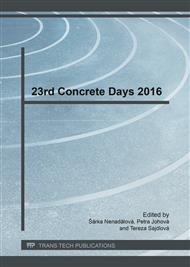[1]
AFGC/SETRA (2013).: Bétons fibrés à ultra-hautes performances. Recommandations. Documents scientifiques et techniques. Association Française de Génie Civil, Setra (in English).
Google Scholar
[2]
Bornemann, R.; Schmidt, M.; Fehling, E.; Middendorf, B.: Ultra-Hochleistungsbeton UHPC – Herstellung, Eigenschaften und Anwendungsmöglichkeiten. Beton- und Stahlbetonbau 96 (7), pp.458-467, (2001).
DOI: 10.1002/best.200100550
Google Scholar
[3]
JSCE-USC: Recommendations for Design and Construction of Ultra-High Strength Fiber-Reinforced Concrete Structures – Draft (in English).
Google Scholar
[4]
Li V.C.: Engineered Cementitious Composites - Tailored Composites through Micromechanical Modeling, in Fiber Reinforced Concrete: Present and the Future, Canadian Society of Civil Engineering, 64-97.
Google Scholar
[5]
Kabele, P., Sajdlová, T., Rydval, M., Kolísko, J.: Modeling of High-Strength FRC Structural Elements with Spatially Non-Uniform Fiber Volume Fraction. Journal of Advanced Concrete Technology Vol. 13, 311-324, June 2015. doi: 10. 3151/jact. 13. 311.
DOI: 10.3151/jact.13.311
Google Scholar
[6]
Sajdlová, T. and Kabele, P., (2014).: Numerical analysis of layered UHPFRC-SHCC structural elements. In: Proceedings of 3rd International RILEM Conference on Strain Hardening Cementitious Composite, Dordrecht, Netherlands, 03. - 05. Nov., 211-218.
Google Scholar
[7]
Maalej, M., Hashida, T. and Li, V.C.: Effect Of Fiber Volume Fraction On The OffCrack-Plane Fracture Energy In Strain-Hardening Engineered Cementitious Composites. J. Amer. Ceramics Soc., 78 (12) 1995, pp.3369-3375.
DOI: 10.1111/j.1151-2916.1995.tb07979.x
Google Scholar
[8]
Kabele, P., Li, V.C., Horii, H., Kanda, T. and Takeuchi, S.: Use of BMC for Ductile Structural Members. in Proc. of 5th International Symposium on Brittle Matrix Composites (BMC-5), Warsaw, Poland, pp.579-588, Oct., (1997).
Google Scholar
[9]
Dhawale, Dr. A. W.: Engineered Cementitious Composites for Structural Applications. In. International Journal of Application or Innovation in Engineering and Management, Volume 2, Issue 4, 2013, pp.198-205. ISSN 2319-4847.
Google Scholar
[10]
Li, V. C.: Advances in strain hardening cement based composites. In: Engineering Foundation Conference on Advances in cement and concrete New Hampshire, July, 1994. pp.24-9.
Google Scholar
[11]
Li, V.C.: From mechanics to structural engineering - The design of cementitious composites for civil engineering applications Structural Engineering/Earthquake Engineering (1993) 10: 37s-48s.
Google Scholar
[12]
En Hua Yang. Et al.: Use of high volume fly ash to improve ECC Mechanical Properties and Material Greenness. ACI Materials Journal/November-December 2007. pp.303-311. (2007).
DOI: 10.14359/18966
Google Scholar
[13]
Mustafa Sahmaran et al.: Assessing the durability of engineered cementitious composites under freezing and thawing cycles. Journal of ASTM International, Vol. 6, No. 7, Paper ID JAI102406. pp.1-12. (2009).
DOI: 10.1520/jai102406
Google Scholar
[14]
Kabele, P.: Assessment of structural performance of engineered cementitious composites by computer simulation. CTU Reports 4 (5), Czech Technical University, Prague. (2001).
Google Scholar
[15]
Suthiwarapirak, P., Matsumoto, T., Kanda, T.: Flexural fatique failure characteristics of an engineered cementitious comporite and polymer cement mortars. In: Journal of Materials, Concrete Structures and Pavements, Japan Society of Civil Engineers. No. 718/V-57, pp.121-134. (2002).
DOI: 10.2208/jscej.2002.718_121
Google Scholar


